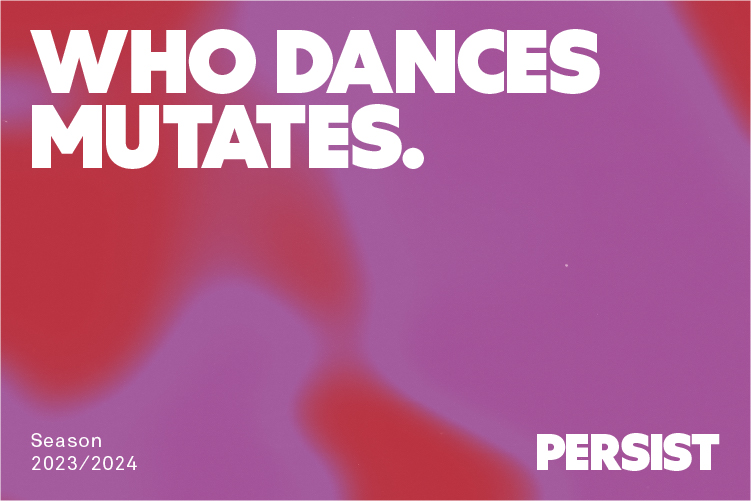2023-24 Season Presentation
Who dances mutates… Persist.
Who dances mutates… Persist.

When a body doesn’t move, there’s no way of knowing how it dances, how it expresses itself in motion. You might say there is a part of the being that can only be revealed through dance, which emerges with the body in motion, when movement wants to become dance; this perspective suggests that we don’t really know someone until we have seen them dance.
Who dances MUTATES is a new invitation to look, listen and read each body and to be seduced by the proposals of artists who put their bodies on the line and, through dance, reveal other looks, imaginaries and narratives that will leave no one unmoved.
Today, dance and the forms, styles, techniques and aesthetics in which it arose in one geographic region and in a specific context are transferred and assimilated on the other side of the world, absorbed by other societies and cultural communities.
Dance is a universal language, a very dynamic, living cultural heritage that is shared globally. In this journey of cultural transmission of bodily knowledge, dance is reinvented in every context and in every body.
However, bodies carry a deep legacy: in the flesh, in the bones, in the cultural gestures, in the body’s dialogue with the environment, in its uniqueness, a story that, thanks to its manifestation through the body, dance makes more visible.
The season offers us the chance to see bodies, dancers and dances with very diverse offerings from very distant places around the world. The audience will bear witness to the cultural transmission of dance languages, a transfer of dances that have travelled the world to be rewritten in each place.
The 2023/24 season takes us on a geographical tour that charts long-distance connections: Lebanon, Norway, Catalonia, Canada, Taiwan, Czech Republic, Spain, Italy, France, Australia, Belgium, South Africa, Hungary, Germany… In parallel, it is a season underpinned by many of the different topics that concern us today, such as feminism, gender, identity, spirituality, community, sustainability approached from the point of view of the body and dance.
The season kicks off with Beytna, by the Lebanese company Omar Rajeh / Maqamat, a work that stages a meeting between artist friends from different countries who dance and cook as a family and who share food with us as a celebration of life and the start of a new season.
Artists such as Maud Le Pladec will highlight the heritage and the cultural transmission of dance, one of the central pillars in this choreographer’s research that we can see in Silence Legacy.
This season the Panorama Taiwan series will bring us a little closer to the choreographic creations of this country, with four companies ranging from the large-scale 13 Tongues, by Cloud Gate, to the more intimate piece Beings, by Wang Yeu Kwn.
Two choreographers whose unique writing we can enjoy for the first time in Barcelona will present their two latest pieces. The Canadian Catherine Gaudet, who was scheduled to appear in the 2019/20 season and whom the pandemic prevented us from seeing, returns with Se dissoudre and The Pretty Things.
The French choreographer Lara Barsacq, whose hybrid and feminist look at dance takes inspiration from, reviews and deconstructs fragments of the history of dance, will be presenting Fruit Tree and La Grande Nymphe, the latest creation emerging from her research.
There will be new large-scale performances by resident artists Aina Alegre, with This is not (an act of love and resistance), and Núria Guiu, with Supermedium, a new project within the framework of the CÈL·LULA project. We also present a new artist associated with the Mercat de les Flors this season: Joaquín Collado, with his project Hacia un sol negro.
Norway will be especially present with three creations: Medium, by Ingri Fiksdal with Núria Guiu, the prestigious company Carte Blanche, and Daniel Mariblanca, with his company 71Bodies.
Contemporary flamenco will also feature with two pieces by Olga Pericet, La Leona and La Materia, the latter a creation in dialogue with Daniel Abreu. We also introduce a new, emerging voice in flamenco: Vanesa Aibar, accompanied by the musician Enric Monfort, with La Reina del Metal.
The piece Corps extrêmes, by choreographer Rachid Ouramdane, breaks down boundaries between physical disciplines, where dance, climbing, tightrope walking and circus acrobatics fuse into a spectacular on-stage performance.
The circus in fact features heavily this year, with the Circ d’Ara Mateix festival. Among the featured artists from all over the world is Alexander Vantournhoud, a creator who moves between choreographic composition and the circus, whose show Foreshadow will be premiering here.
Our collaboration with different festivals continues: once again, the Mercat de les Flors will welcome the Hacer Historia(s) series in October and the Sâlmon live arts festival in February. Likewise, we will be hosting the elPetit festival for children aged 0 to 5 years in November and the HOP urban dance festival in December.
We will end the season with Kobe, by Vero Cendoya, and with Harmonia, by the company Unusual Symptoms with Adrienn Hód/Hodworks, a show that will fill you with energy and joie de vivre. Two creations that demonstrate that we never know just what the body can do.
But there is much more: this guide offers you detailed information on the creations that are currently under development. Throughout the season we will see creations by Constanza Brnčić, Magi Serra, Sonia Gómez, Sol Picó, Aimar Pérez Galí, La Veronal, Toni Mira, Big Bouncers, Thomas Noone, Guy Nader and Maria Campos, Animal Religion, La Taimada, Janet Novás, Amala Dianor and Marco da Silva Ferreira, and many more. We look forward to seeing you at the Mercat de les Flors.
Who dances mutates… Persist.
Àngels Margarit,
Director of Mercat de les Flors